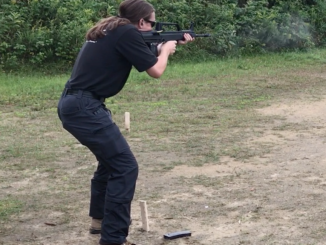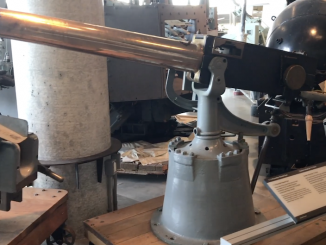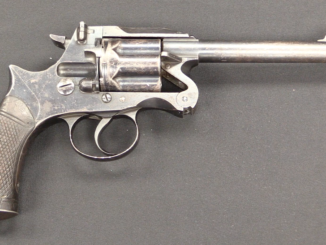In 1943 the need for a lighter and handier version of the Lee Enfield rifle became clear throughout the British Commonwealth, and experimentation began in Canada, Britain, and Australia. The work in Britain would culminate in the No5 Mk1 rifle, but the Canadian arsenal at Long Branch would try some different ideas first. Several different experimental prototypes were made with varying features, but they all shared the idea of substantially lightening the rifle without shortening it very much. This was done by removing metal anywhere possible, most obviously including the elimination of the stock socket and the use of a single piece stock in place of the traditional two piece Enfield stock.
These modifications, also including an aluminum alloy trigger guard, were able to cut 25% of the weight from the rifle, and do so without a significant loss in accuracy. However, I suspect the resulting rifle would have proven far too fragile for combat use had it been adopted. The stock is surprisingly light and thin at the wrist, and it feels like it would not take much force to crack it. In addition, lightening cuts down the length of the hand guard made it quite susceptible to warping with heat and humidity changes.
Ultimately the Long Branch Lee Enfield carbine experiments would be abandoned as the No5 “Jungle Carbine” was adopted instead.




The version of the Canadian Red Ensign you show on your video is the First World War version, the version that was used during the Second World War had a simplified crest on it.
The twin lumps added to the barrel for a bayonet stop remind me of the 3 lumps added to the barrel of an experimental 7.7 Japanese carbine in their 1938 tests. I think the serial# of it is 13 also.
Long Branch Arsenal was more formally known as Small Arms Ltd. It was a “Crown Corporation”, that is operated as a business (to get around cumbersome government purchasing regulations) but owned by the Canadian government. They were located at the western edge of Toronto and produced Stens as well as Lee Enfields.
Behind the scenes work on starting up a new arsenal was begun several years before the war when it became apparent that things were not going well in Europe. Thus, they weren’t starting from ground zero when the war actually begun. Instead they already had people in the UK studying how to make Lee Enfields and were making other preparations. The land for the factory already belonged to the government as part of a military rifle range.
After the war they were amalgamated with other government owned arms factories to become part of Canadian Arsenals Ltd. and remained in operation (on a reduced scale) until 1974.
After the war they made prototypes of the EM2 bullpup until that project was killed by the US insisting on 7.62x51mm as the standard NATO cartridge. They then switched to making the C1 – the Canadian version of the FN FAL. They also made pistols (Browning HP) and submachine guns (Sterling).
Here’s more information on the factory and its history.
http://heritagemississauga.com/assets/Small%20Arms%20Final%20Report%20-%20by%20Liwen%20Chen.pdf
Interesting addition; I thought HPs (still in service) were the last made by J. Inglis.
Is recoil taken by the vestigial lug on the rear of the receiver?
Or were the “draws” bedded as well?
Was the trigger a variation of the trigger used on the Mauser models from 1892-98…?
Awesome to see this one on here!
One of my favorite rifles of all time and if I could choose, I would definitely go for the first WW version as well, but that’s probably just personal preference.
IIRC, Canadian engineers questioned the uneven mass of the left and right receiver walls on the No.4, but I don’t believe this was ever considered to be a source of the famous “wandering zero” of the No.5 for the simple reason that the No.5 had the same amount of metal forward of the charger bridge as the No.4. It was the lightening of the No.5 receiver BEHIND the recoil lugs (behind the charger bridge) which was felt to possibly cause the “wandering zero”. In retrospect, if they had followed the example of the No.1 Mk.VI Rifle, which was clearly followed on this Long Branch lightened No.4, and taken more metal from the left receiver wall rather than behind the recoil lugs, probably there would never have been any such problem with maintaining zero.